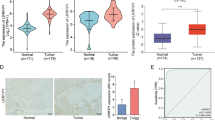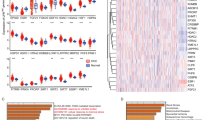Abstract
Although gemcitabine-based chemotherapy is one of the more effective chemotherapy regimens against NSCLC, there are still many patients who do not benefit from this therapy. The mechanism of initial or acquired resistance to gemcitabine chemotherapy remains unknown. In this study, we investigated the protein profiling in gemcitabine-resistant and gemcitabine-sensitive NSCLC cell lines by a proteomic technology in order to identify novel gemcitabine resistance associated biomarkers for NSCLC patients. The proteomic profiling of NSCLC cell line H460 and its gemcitabine-resistant subline H460/GEM were compared by an isotope-coded affinity tag technology and tandem mass spectrometry. We further validated the expression of sorcin, a gemcitabine-resistance-related protein identified by proteomics, in 62 NSCLC specimens by immunohistochemistry. Fourteen gemcitabine resistance-related proteins were identified including nine up-regulated proteins and five down-regulated proteins. Immunohistochemical results demonstrated that sorcin staining was seen in 66.1% of NSCLC tumors, and sorcin overexpression was associated with gemcitabine resistance and a poor prognosis in NSCLC patients. In conclusion, sorcin might play an important role in the resistibility to gemcitabine, and it could also be a novel candidate biomarker for predicting the response of NSCLC patients to gemcitabine treatment.



Similar content being viewed by others
References
Jemal A, Thomas A, Murray T, Thun M. Cancer statistics. CA Cancer J Clin. 2002;52:23–47.
Schiller JH, Harrington D, Belani CP, Langer C, Sandler A, Krook J, et al. Comparison of four chemotherapy regimens for advanced non-small-cell lung cancer. N Engl J Med. 2002;346:92–8.
Danesi R, Altavilla G, Giovannetti E, Rosell R. Pharmacogenomics of gemcitabine in non-small-cell lung cancer and other solid tumors. Pharmacogenomics. 2009;10:69–80. Review.
Sève P, Dumontet C. Chemoresistance in non-small cell lung cancer. Curr Med Chem Anticancer Agents. 2005;5:73–88. Review.
Ho CC, Kuo SH, Huang PH, Huang HY, Yang CH, Yang PC. Caveolin-1 expression is significantly associated with drug resistance and poor prognosis in advanced non-small cell lung cancer patients treated with gemcitabine-based chemotherapy. Lung Cancer. 2008;59:105–10.
Akada M, Crnogorac-Jurcevic T, Lattimore S, Mahon P, Lopes R, Sunamura M, et al. Intrinsic chemoresistance to gemcitabine is associated with decreased expression of BNIP3 in pancreatic cancer. Clin Cancer Res. 2005;11:3094–101.
Mori-Iwamoto S, Kuramitsu Y, Ryozawa S, Mikuria K, Fujimoto M, Maehara S, et al. Proteomics finding heat shock protein 27 as a biomarker for resistance of pancreatic cancer cells to gemcitabine. Int J Oncol. 2007;31:1345–50.
Davidson JD, Ma L, Flagella M, Geeganage S, Gelbert LM, Slapak CA. An increase in the expression of ribonucleotide reductase large subunit 1 is associated with gemcitabine resistance in non-small cell lung cancer cell lines. Cancer Res. 2004;64:3761–6.
Li J, Steen H, Gygi SP. Protein profiling with cleavable isotope-coded affinity tag (cICAT) reagents: the yeast salinity stress response. Mol Cell Proteomics. 2003;2:1198–204.
Sethuraman M, McComb ME, Heibeck T, Costello CE, Cohen RA. Isotope-coded affinity tag approach to identify and quantify oxidant-sensitive protein thiols. Mol Cell Proteomics. 2004;3:273–8.
Rosell R, Taron M, Alberola V, Massuti B, Felip E. Genetic testing for chemotherapy in non-small cell lung cancer. Lung Cancer. 2003;41:S97–102.
Oguri T, Achiwa H, Muramatsu H, Ozasa H, Sato S, Shimizu S, et al. The absence of human equilibrative nucleoside transporter 1 expression predicts nonresponse to gemcitabine-containing chemotherapy in non-small cell lung cancer. Cancer Lett. 2007;256:112–9.
Castagna A, Antonioli P, Astner H, Hamdan M, Righetti SC, Perego P, et al. A proteomic approach to cisplatin resistance in the cervix squamous cell carcinoma cell line A431. Proteomics. 2004;4:3246–67.
Liu Y, Liu H, Han B, Zhang JT. Identification of 14–3-3sigma as a contributor to drug resistance in human breast cancer cells using functional proteomic analysis. Cancer Res. 2006;66:3248–55.
Yang YX, Chen ZC, Zhang GY, Yi H, Xiao ZQ. A subcellular proteomic investigation into vincristine-resistant gastric cancer cell line. J Cell Biochem. 2008;104:1010–21.
Pan S, Cheng L, White JT, Lu W, Utleg AG, Yan X, et al. Quantitative proteomics analysis integrated with microarray data reveals that extracellular matrix proteins, catenins, and p53 binding protein 1 are important for chemotherapy response in ovarian cancers. OMICS. 2009;13:345–54.
Keenan J, Murphy L, Henry M, Meleady P, Clynes M. Proteomic analysis of multidrug-resistance mechanisms in adriamycin-resistant variants of DLKP, a squamous lung cancer cell line. Proteomics. 2009;9:1556–66.
Hasegawa N, Mizutani K, Suzuki T, Deguchi T, Nozawa Y. A comparative study of protein profiling by proteomic analysis in camptothecin-resistant PC3 and camptothecin-sensitive LNCaP human prostate cancer cells. Urol Int. 2006;77:347–54.
Qi J, Liu N, Zhou Y, Tan Y, Cheng Y, Yang C, et al. Overexpression of sorcin in multidrug resistant human leukemia cells and its role in regulating cell apoptosis. Biochem Biophys Res Commun. 2006;349:303–9.
Zhou Y, Xu Y, Tan Y, Qi J, Xiao Y, Yang C, et al. Sorcin, an important gene associated with multidrug-resistance in human leukemia cells. Leuk Res. 2006;30:469–76.
Kawakami M, Nakamura T, Okamura N, Komoto C, Markova S, Kobayashi H, et al. Knock-down of sorcin induces up-regulation of MDR1 in HeLa cells. Biol Pharm Bull. 2007;30:1065–73.
Author information
Authors and Affiliations
Corresponding author
Rights and permissions
About this article
Cite this article
Qu, Y., Yang, Y., Liu, B. et al. Comparative proteomic profiling identified sorcin being associated with gemcitabine resistance in non-small cell lung cancer. Med Oncol 27, 1303–1308 (2010). https://doi.org/10.1007/s12032-009-9379-5
Received:
Accepted:
Published:
Issue Date:
DOI: https://doi.org/10.1007/s12032-009-9379-5




